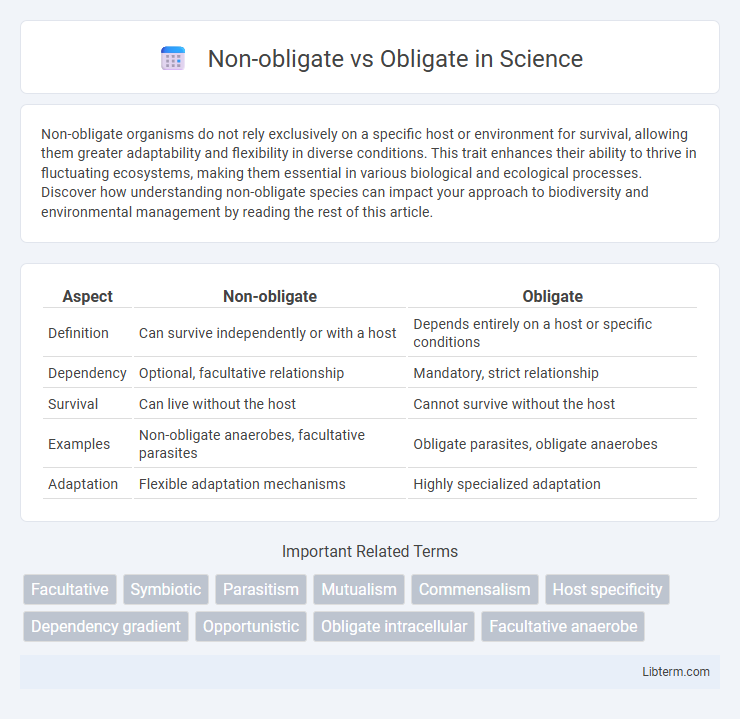Non-obligate organisms do not rely exclusively on a specific host or environment for survival, allowing them greater adaptability and flexibility in diverse conditions. This trait enhances their ability to thrive in fluctuating ecosystems, making them essential in various biological and ecological processes. Discover how understanding non-obligate species can impact your approach to biodiversity and environmental management by reading the rest of this article.
Table of Comparison
| Aspect | Non-obligate | Obligate |
|---|---|---|
| Definition | Can survive independently or with a host | Depends entirely on a host or specific conditions |
| Dependency | Optional, facultative relationship | Mandatory, strict relationship |
| Survival | Can live without the host | Cannot survive without the host |
| Examples | Non-obligate anaerobes, facultative parasites | Obligate parasites, obligate anaerobes |
| Adaptation | Flexible adaptation mechanisms | Highly specialized adaptation |
Understanding Non-Obligate and Obligate Relationships
Non-obligate relationships are interactions between species where both organisms can survive independently, such as certain mutualisms where benefits are exchanged but not essential for survival. Obligate relationships require at least one organism to depend entirely on the other for survival, exemplified by some symbiotic partnerships like the relationship between certain fungi and algae in lichens. Understanding these distinctions clarifies ecological dependencies and evolutionary adaptations influencing species survival and ecosystem dynamics.
Key Definitions: Non-Obligate vs Obligate
Non-obligate organisms can survive in multiple environments by switching between different modes of nutrition or lifestyles, while obligate organisms rely exclusively on a specific mode or host to survive. Obligate symbionts depend entirely on their host for survival and reproduction, contrasting with non-obligate species that maintain independence under varying conditions. Understanding the distinction between non-obligate and obligate entities is crucial in fields like microbiology, ecology, and parasitology for classifying organism behaviors and dependencies.
Biological Context: Non-Obligate and Obligate Interactions
Obligate interactions in biology refer to relationships where species depend entirely on each other for survival or reproduction, such as obligate mutualism seen between certain pollinators and plants. Non-obligate interactions occur when species benefit from each other but can survive independently, exemplified by facultative mutualism where organisms interact opportunistically. Understanding these distinctions clarifies ecological dynamics, species coexistence, and evolutionary adaptations in ecosystems.
Differences in Mutualistic Associations
Non-obligate mutualistic associations involve partners that can survive independently, engaging in mutually beneficial interactions only when conditions allow, such as cleaner fish and their hosts. Obligate mutualistic associations require the partners to depend entirely on one another for survival or reproduction, exemplified by the relationship between certain pollinators and specific flowering plants. The primary difference lies in the dependency level: non-obligate associations are facultative and flexible, while obligate associations are strict and essential for the involved species' life cycles.
Examples of Obligate vs Non-Obligate Organisms
Obligate organisms, such as obligate anaerobes like Clostridium botulinum, require specific environmental conditions, like the absence of oxygen, to survive. Non-obligate organisms include facultative anaerobes like Escherichia coli, which can grow with or without oxygen. Obligate parasites, such as Plasmodium falciparum, depend entirely on a host for their life cycle, whereas non-obligate parasites like ticks can survive both on a host and independently in the environment.
Evolutionary Advantages of Non-Obligate and Obligate Strategies
Non-obligate organisms exhibit evolutionary advantages by flexibly adapting to diverse environments through facultative behaviors, increasing survival during fluctuating conditions. Obligate organisms demonstrate specialization benefits by optimizing resources and interactions with their environment or hosts, leading to enhanced efficiency and stability in predictable niches. This evolutionary trade-off highlights non-obligate strategies fostering resilience and adaptability, while obligate strategies promote specialization and competitive dominance.
Ecological Impacts of Obligate and Non-Obligate Relationships
Obligate relationships create specialized dependencies between species, often leading to co-evolution and increased ecosystem stability but also vulnerability to environmental changes. Non-obligate relationships offer greater ecological flexibility, promoting biodiversity by allowing species to interact opportunistically without strict survival reliance. The balance between these relationship types influences ecosystem resilience, species diversity, and overall ecological dynamics.
Adaptations in Non-Obligate and Obligate Species
Non-obligate species exhibit flexible adaptations allowing survival in varying environments by utilizing multiple resources or hosts, often showing phenotypic plasticity and behavioral versatility. Obligate species possess specialized adaptations tightly linked to a single resource or host, such as morphological traits or metabolic pathways optimized for specific conditions, which restrict their ecological niche. These distinct evolutionary strategies highlight the trade-off between specialization and adaptability in organismal survival and reproduction.
Challenges in Distinguishing Non-Obligate from Obligate Interactions
Distinguishing non-obligate from obligate interactions presents challenges due to overlapping behavioral and ecological traits, where non-obligate partners may occasionally exhibit dependence resembling obligate ones. Variability in environmental conditions and the plasticity of mutualistic relationships complicate clear categorization, as non-obligate interactions can shift towards obligate under resource scarcity or stress. Accurate differentiation requires integrative approaches combining genetic, physiological, and longitudinal ecological data to capture dynamic interaction patterns.
Summary: Importance of Recognizing Obligacy in Nature
Recognizing obligacy in nature is crucial for understanding species interactions and ecosystem stability, as obligate relationships involve organisms that depend entirely on one another for survival or reproduction. Differentiating obligate from non-obligate interactions helps ecologists identify critical dependencies that influence biodiversity conservation and habitat management. Accurate knowledge of these dependencies enables more effective strategies to protect keystone species and maintain ecological balance.
Non-obligate Infographic

 libterm.com
libterm.com